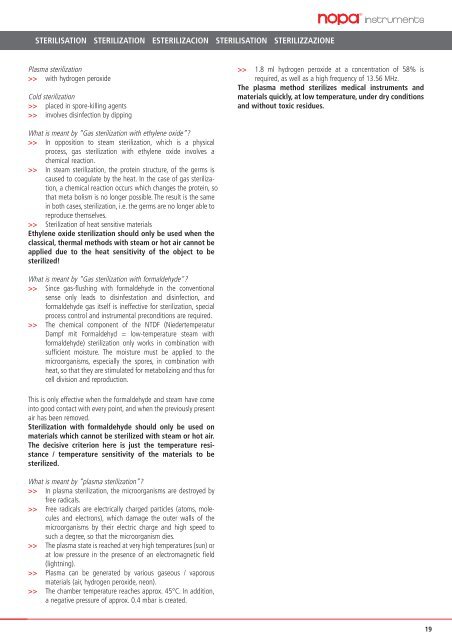Download - nopa instruments
Download - nopa instruments
Download - nopa instruments
Sie wollen auch ein ePaper? Erhöhen Sie die Reichweite Ihrer Titel.
YUMPU macht aus Druck-PDFs automatisch weboptimierte ePaper, die Google liebt.
STERILISATION STERILIZATION ESTERILIZACION STERILISATION STERILIZZAZIONE<br />
Plasma sterilization<br />
>> with hydrogen peroxide<br />
Cold sterilization<br />
>> placed in spore-killing agents<br />
>> involves disinfection by dipping<br />
>> 1.8 ml hydrogen peroxide at a concentration of 58% is<br />
required, as well as a high frequency of 13.56 MHz.<br />
The plasma method sterilizes medical <strong>instruments</strong> and<br />
materials quickly, at low temperature, under dry conditions<br />
and without toxic residues.<br />
What is meant by “Gas sterilization with ethylene oxide”?<br />
>> In opposition to steam sterilization, which is a physical<br />
process, gas sterilization with ethylene oxide involves a<br />
chemical reaction.<br />
>> In steam sterilization, the protein structure, of the germs is<br />
caused to coagulate by the heat. In the case of gas sterilization,<br />
a chemical reaction occurs which changes the protein, so<br />
that meta bolism is no longer possible. The result is the same<br />
in both cases, sterilization, i.e. the germs are no longer able to<br />
reproduce themselves.<br />
>> Sterilization of heat sensitive materials<br />
Ethylene oxide sterilization should only be used when the<br />
classical, thermal methods with steam or hot air cannot be<br />
applied due to the heat sensitivity of the object to be<br />
sterilized!<br />
What is meant by “Gas sterilization with formaldehyde"?<br />
>> Since gas-flushing with formaldehyde in the conventional<br />
sense only leads to disinfestation and disinfection, and<br />
formaldehyde gas itself is ineffective for sterilization, special<br />
process control and instrumental preconditions are required.<br />
>> The chemical component of the NTDF (Niedertemperatur<br />
Dampf mit Formaldehyd = low-temperature steam with<br />
formaldehyde) sterilization only works in combination with<br />
sufficient moisture. The moisture must be applied to the<br />
microorganisms, especially the spores, in combination with<br />
heat, so that they are stimulated for metabolizing and thus for<br />
cell division and reproduction.<br />
This is only effective when the formaldehyde and steam have come<br />
into good contact with every point, and when the previously present<br />
air has been removed.<br />
Sterilization with formaldehyde should only be used on<br />
materials which cannot be sterilized with steam or hot air.<br />
The decisive criterion here is just the temperature resistance<br />
/ temperature sensitivity of the materials to be<br />
sterilized.<br />
What is meant by “plasma sterilization”?<br />
>> In plasma sterilization, the microorganisms are destroyed by<br />
free radicals.<br />
>> Free radicals are electrically charged particles (atoms, molecules<br />
and electrons), which damage the outer walls of the<br />
microorganisms by their electric charge and high speed to<br />
such a degree, so that the microorganism dies.<br />
>> The plasma state is reached at very high temperatures (sun) or<br />
at low pressure in the presence of an electromagnetic field<br />
(lightning).<br />
>> Plasma can be generated by various gaseous / vaporous<br />
materials (air, hydrogen peroxide, neon).<br />
>> The chamber temperature reaches approx. 45°C. In addition,<br />
a negative pressure of approx. 0.4 mbar is created.<br />
19



